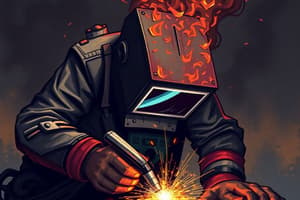Podcast
Questions and Answers
Which shielding gas is MOST suitable for welding carbon steel due to its cost-effectiveness and good penetration?
Which shielding gas is MOST suitable for welding carbon steel due to its cost-effectiveness and good penetration?
- Argon/Oxygen mixture
- Carbon Dioxide (CO2) (correct)
- Helium
- Argon
In MIG welding, what effect does increasing the voltage typically have on the arc length and weld bead?
In MIG welding, what effect does increasing the voltage typically have on the arc length and weld bead?
- Decreases arc length and widens weld bead
- Increases arc length and widens weld bead (correct)
- Increases arc length and narrows weld bead
- Decreases arc length and narrows weld bead
Which metal transfer mode in MIG welding is best suited for welding thin materials and in out-of-position scenarios?
Which metal transfer mode in MIG welding is best suited for welding thin materials and in out-of-position scenarios?
- Spray Transfer
- Short Circuit Transfer (correct)
- Pulsed Spray Transfer
- Globular Transfer
What is the primary advantage of using the 'push technique' in MIG welding, particularly for thinner materials?
What is the primary advantage of using the 'push technique' in MIG welding, particularly for thinner materials?
Which of the following defects is LEAST likely to be caused by insufficient shielding gas coverage during MIG welding?
Which of the following defects is LEAST likely to be caused by insufficient shielding gas coverage during MIG welding?
In MIG welding, what function does the wire feeder serve?
In MIG welding, what function does the wire feeder serve?
When welding aluminum with the MIG process, which shielding gas is typically recommended?
When welding aluminum with the MIG process, which shielding gas is typically recommended?
What is the MOST likely cause of 'lack of fusion' in a MIG weld?
What is the MOST likely cause of 'lack of fusion' in a MIG weld?
Which welding position is generally considered the MOST challenging for a welder to perform?
Which welding position is generally considered the MOST challenging for a welder to perform?
What is the purpose of a ground clamp in MIG welding?
What is the purpose of a ground clamp in MIG welding?
Which advanced MIG welding technique is designed to automatically adjust welding parameters based on the material type and thickness?
Which advanced MIG welding technique is designed to automatically adjust welding parameters based on the material type and thickness?
What is the main advantage of using pulsed spray transfer over conventional spray transfer in MIG welding?
What is the main advantage of using pulsed spray transfer over conventional spray transfer in MIG welding?
Which of the following is a key safety precaution to take when MIG welding?
Which of the following is a key safety precaution to take when MIG welding?
What is the function of the shielding gas in MIG welding?
What is the function of the shielding gas in MIG welding?
How does increasing the wire feed speed typically affect the weld bead size in MIG welding?
How does increasing the wire feed speed typically affect the weld bead size in MIG welding?
Flashcards
MIG Welding (GMAW)
MIG Welding (GMAW)
Arc welding process using continuous wire, joining materials with shielding gas.
Welding Power Source
Welding Power Source
Provides electrical power to create the arc and melt metal in welding.
Wire Feeder
Wire Feeder
Supplies welding wire to the welding gun at a controlled rate.
Welding Gun
Welding Gun
Signup and view all the flashcards
Shielding Gas
Shielding Gas
Signup and view all the flashcards
Welding Preparation
Welding Preparation
Signup and view all the flashcards
Arc Length
Arc Length
Signup and view all the flashcards
Porosity (Welding)
Porosity (Welding)
Signup and view all the flashcards
Lack of Fusion
Lack of Fusion
Signup and view all the flashcards
Undercut (Welding)
Undercut (Welding)
Signup and view all the flashcards
PPE
PPE
Signup and view all the flashcards
Short Circuit Transfer
Short Circuit Transfer
Signup and view all the flashcards
Spray Transfer
Spray Transfer
Signup and view all the flashcards
Solid Wire
Solid Wire
Signup and view all the flashcards
Welding Maintenance
Welding Maintenance
Signup and view all the flashcards
Study Notes
- MIG (Metal Inert Gas) welding, also known as Gas Metal Arc Welding (GMAW), is an arc welding process where a continuous solid wire electrode is fed through a welding gun and into the weld pool, joining the two base materials together
- A shielding gas is also fed through the welding gun, protecting the weld pool from atmospheric contamination
- MIG welding is a versatile process that can be used to weld a variety of metals, including steel, aluminum, and stainless steel
Key Components
- Welding Power Source: Provides the electrical power necessary to create the arc and melt the metal
- Wire Feeder: Supplies the welding wire to the welding gun at a controlled rate
- Welding Gun: Directs the welding wire and shielding gas to the weld area
- Shielding Gas Supply: Provides the shielding gas to protect the weld pool from atmospheric contamination
- Ground Clamp: Completes the electrical circuit by connecting the workpiece to the welding power source
Welding Process
- Preparation: Clean the base material and ensure proper fit-up, attach ground clamp
- Setup: Select the appropriate welding parameters (voltage, wire feed speed, gas flow rate) based on the material type and thickness
- Welding: Start the arc by touching the wire electrode to the base material, then move the welding gun along the joint while maintaining a consistent travel speed and arc length
- Post-Welding: Allow the weld to cool, then clean the weld area and inspect the weld for any defects
Shielding Gases
- Argon: Commonly used for welding aluminum and stainless steel
- Carbon Dioxide (CO2): Often used for welding carbon steel due to its low cost and good penetration
- Argon/CO2 Mixtures: Provide a balance of good arc characteristics and weld quality for welding carbon steel
- Helium: Used for welding thicker materials and for increasing weld penetration
- Gas mixtures such as Argon/Oxygen also sometimes used for carbon steel
Welding Techniques
- Push Technique: The welding gun is angled forward, pushing the weld pool ahead, provides better visibility of the weld pool and is often used for welding thin materials
- Pull Technique: The welding gun is angled backward, pulling the weld pool along, provides deeper penetration and is often used for welding thicker materials
- Travel Speed: The speed at which the welding gun is moved along the joint, affects the weld bead size, shape, and penetration
- Arc Length: The distance between the end of the wire electrode and the base material, maintaining a consistent arc length is important for producing a quality weld
Welding Parameters
- Voltage: Affects the arc length and weld bead width, higher voltage results in a longer arc length and a wider weld bead
- Wire Feed Speed: Controls the amount of welding wire that is fed to the weld pool, higher wire feed speed results in a larger weld bead
- Amperage: The current flowing through the welding circuit, directly related to the heat input and the amount of metal melted
- Gas Flow Rate: The rate at which shielding gas is delivered to the weld area, adequate gas flow is essential for preventing atmospheric contamination
Welding Positions
- Flat Position: The easiest welding position, the weld is made on a flat surface from above
- Horizontal Position: The weld is made on a vertical surface with the weld axis horizontal
- Vertical Position: The weld is made on a vertical surface with the weld axis vertical, can be done upwards or downwards
- Overhead Position: The most difficult welding position, the weld is made on a flat surface from below
Advantages
- High Welding Speed: MIG welding is a relatively fast welding process compared to other welding methods
- Versatility: Can be used to weld a variety of metals and in various positions
- Ease of Use: Relatively easy to learn and operate compared to other welding processes
- Clean Welds: Produces clean welds with minimal slag
- Automation: Easily automated and used in robotic welding systems
Disadvantages
- Equipment Cost: The initial cost of the equipment can be relatively high
- Wind Sensitivity: The shielding gas can be blown away by wind, making it difficult to weld outdoors
- Limited Access: The welding gun can be bulky, making it difficult to access tight spaces
- Spatter: Produces weld spatter, which can require additional cleanup
- Fumes: Produces fumes, which can be hazardous to health if proper ventilation is not used
Common Welding Defects
- Porosity: Gas bubbles trapped in the weld metal, caused by insufficient shielding gas or contaminated base material
- Slag Inclusions: Non-metallic solid material trapped in the weld metal, common in multi-pass welds
- Lack of Fusion: Incomplete melting and joining of the base material and weld metal, caused by insufficient heat input or improper welding technique
- Undercut: A groove melted into the base material next to the weld bead, caused by excessive heat input or improper welding technique
- Cracking: Can occur in the weld metal or heat-affected zone, caused by high stress or improper material selection
- Spatter: Small droplets of molten metal that are ejected from the weld area, can be reduced by optimizing welding parameters and using anti-spatter compound
Safety Precautions
- Wear appropriate personal protective equipment (PPE), including a welding helmet with a proper lens shade, gloves, and protective clothing
- Ensure adequate ventilation to remove fumes and gases
- Avoid welding near flammable materials
- Use proper grounding techniques to prevent electric shock
- Inspect welding equipment regularly for damage or wear
- Follow manufacturer's instructions for operating the welding equipment
Metal Transfer Modes
- Short Circuit Transfer: The wire electrode touches the weld pool, creating a short circuit, occurs at lower voltage and amperage settings, suitable for thin materials and out-of-position welding, produces the most spatter
- Globular Transfer: Large droplets of molten metal are transferred across the arc, occurs at higher amperage settings, not suitable for most applications due to excessive spatter and poor weld quality
- Spray Transfer: A stream of small molten metal droplets is transferred across the arc, occurs at higher voltage and amperage settings, provides good weld quality and penetration, but not suitable for out-of-position welding
- Pulsed Spray Transfer: A variation of spray transfer where the welding current is pulsed, allows for better control of heat input and reduces spatter, suitable for a wider range of materials and welding positions
Wire Electrode Types
- Solid Wire: A continuous solid wire electrode, commonly used for MIG welding
- Flux Cored Wire: A tubular wire electrode filled with flux, provides its own shielding and can be used without external shielding gas
- Mild Steel Wire: Used for welding carbon steel
- Stainless Steel Wire: Used for welding stainless steel
- Aluminum Wire: Used for welding aluminum
Applications
- Automotive Repair: Used for repairing car bodies and exhaust systems
- Construction: Used for welding structural steel and pipelines
- Manufacturing: Used for welding a variety of metal products, such as appliances, furniture, and machinery
- DIY Projects: Used by hobbyists and homeowners for various welding projects
Maintenance
- Regularly clean the welding gun and wire feeder
- Inspect and replace worn or damaged parts, such as contact tips and gas nozzles
- Check the shielding gas supply and replace empty cylinders
- Keep the welding machine clean and free of dust and debris
- Periodically inspect the welding cables and connections for damage or wear
Advanced Techniques
- Pulsed MIG Welding: Uses pulsed current to control heat input and reduce spatter
- Double Pulsed MIG Welding: Varies both the current and pulse frequency, used for welding aluminum and other alloys
- Synergic MIG Welding: Automatically adjusts welding parameters based on material type and thickness
- Robotic MIG Welding: Uses robots to automate the welding process, improving productivity and weld quality
Studying That Suits You
Use AI to generate personalized quizzes and flashcards to suit your learning preferences.




